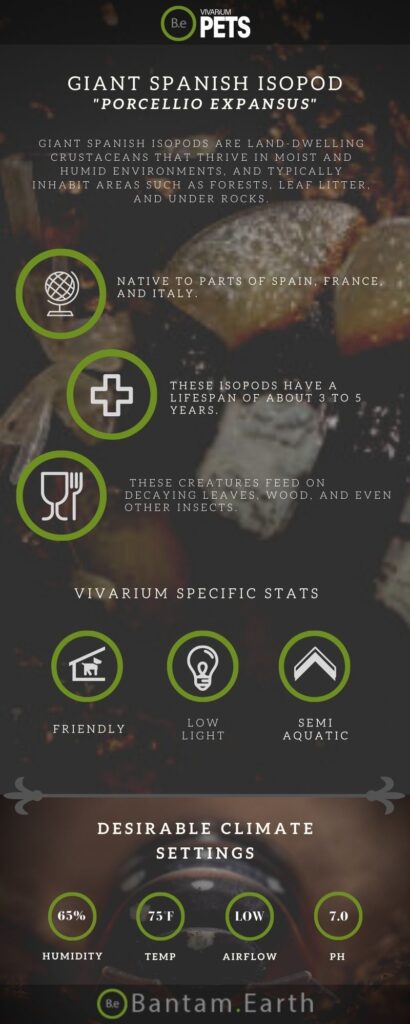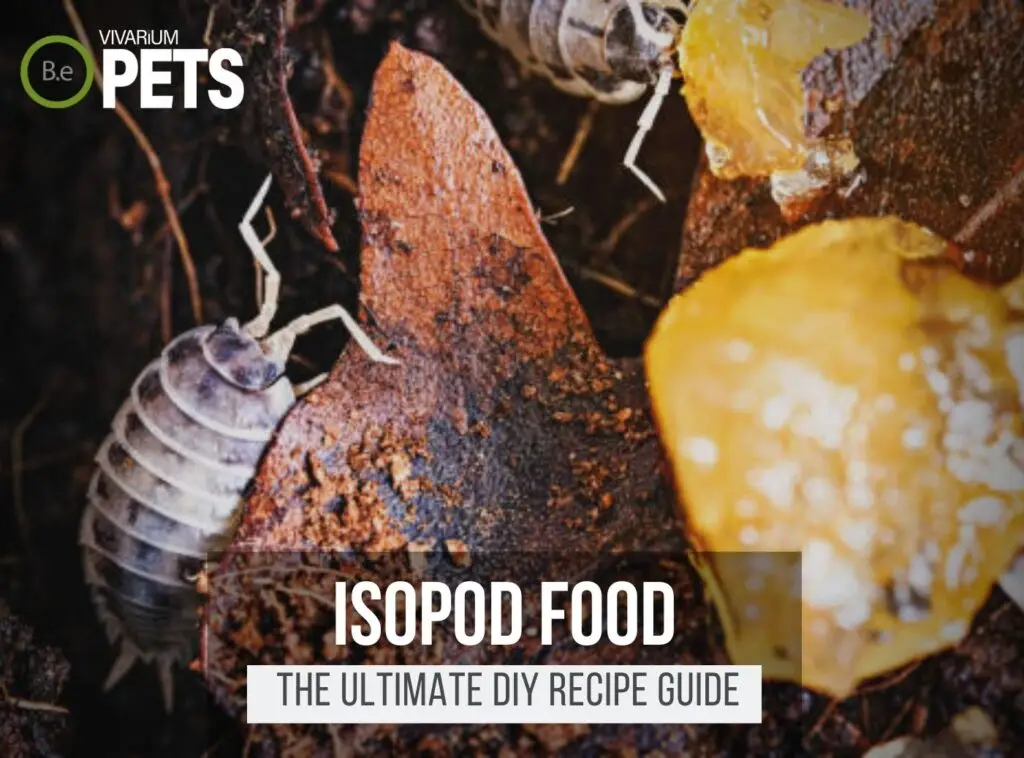If you want to build a medium to large size terrarium with a Spain-influenced look, you’ll need some Spanish decor (like the Seville Cathedral) and some Giant Spanish Isopods!
Porcellio expansus critters are easily recognizable by their unique shape, size, and color, and can make great pets.
This guide will provide essential tips on how to provide the right habitat, diet, and nutrition, and how to interact and handle your Porcellio expansus so that it stays happy, healthy, and stress-free.
Read on to find out more!
| Characteristics: | |
|---|---|
| Common Name | Giant Spanish Isopod |
| Family Name | Porcellionidae |
| Scientific Name | Porcellio expansus |
| Use | Cleaning, Aerating Soil, Feeders |
| Temperament | Non-aggressive |
| Lifespan | 3-5 Years |
| Diet | Detritivore |
| Adult Size | 2.6 cm |
| Breeding Type | Egg Layer |
| Care Level | Moderate |
| Minimum Tank Size | 5-10 Gallons |
| pH | 6.5 - 7.5 |
| Hardness | Medium |
| Temperature | 50-77°F |
What Are Giant Spanish Isopods?
Giant Spanish Isopods, also known as Porcellio expansus, belong to the family of Porcellionidae. They are most known for their large size and their natural tendency to hide or bury themselves during the day.
Giant Spanish Isopods are land-dwelling crustaceans that thrive in moist and humid environments, and typically inhabit areas such as forests, leaf litter, and under rocks.
Native to Spain and parts of the Mediterranean, their common name references the country of origin of their first discovery.
What Do Giant Spanish Isopods Look Like?
Giant Spanish Isopods will typically grow to more than an inch, making them two of the largest land-dwelling Isopods in existence.
They have a solid, segmented body and a tough shell, which is colored in shades of grey and brown.
The back of their shell is covered in granular patterns, which provide the Isopod with camouflage from predators.
They have several pairs of legs, which are equipped with sharp claws for burrowing and digging in the soil.
They have two long, antennae on their head that are used for sensing their environment and locating food.
Benefits Of Using Giant Spanish Isopods
Giant Spanish Isopods are a great addition to vivariums for several reasons.
They help provide ground-level activity and interest, which is especially important for species that don’t like climbing.
They also help aerate and break down debris, providing a beneficial ecosystem to the enclosure’s inhabitants.
These isopods can also act as helpful pest controllers in the form of eating leftover food and decaying plant matter.
They play an important role in nutrient cycles and have both scavenging and detritivore dietary needs.
Keeping isopods in a bioactive terrarium can help create micro-climates and keep the substrate damp, which is essential for many types of plants.
The Giant Spanish Isopod is also a great pet by itself. It is easy to keep, requires minimal maintenance, and can provide hours of amusement with its colorful behavior.


Giant Spanish Isopods Facts
Porcellio expansus is a species of terrestrial crustaceans which typically inhabits Spain as well as other surrounding countries.
They are generally peaceful in temperament and their lifespan is typically 3+ years, although the oldest recorded specimen lived for 5 years.
Breeding is common among the species, with females laying up to 100 eggs during the reproductive cycle.
Habitat
Giant Spanish Isopods are a species of terrestrial isopod that are native to parts of Spain, France, and Italy.
They are very hardy and tolerant of slightly varying temperatures and humidity levels, which makes them popular among invertebrate hobbyists.
In their natural habitat, they live among rocks, logs, and decaying plant matter in woodlands, meadows, and other moderately humid environments.
They are also known to be able to tolerate cooler temperatures and are found in both mountain and temperate rainforest areas.
They have also been found to be incredibly resilient, managing to bounce back quickly from temporary disruptions in their environment, so long as the proper conditions for their habitat are restored.
Diet
In their natural environment, Porcellio expansus feed on decaying leaves, wood, and even other insects.
They are most active at night when they scavenge the area for food and look for potential mates.
As they are decomposers, they can also help break down dead plant material, aiding in the natural cycle of their native environments.
In the wild, they consume various fruits, vegetables, flower petals, and even small insects, making them omnivorous.
Temperament
Giant Spanish Isopods are nocturnal animals known for their peaceful temperament and low-maintenance care requirements.
You won’t find them attempting to bite or act hostile around humans or other animals. In fact, they are the perfect pet for those with little to no experience with isopods.
Giant Spanish Isopods tend to be quite shy around humans, often attempting to run and hide in response to loud noises and sudden movements.
As with any type of pet, however, getting your isopods used to your presence will allow for easier handling and more positive interactions for everyone involved.
Because Porcellio expansus are relatively small and fragile, it’s important to take extra precautions when handling them and to avoid squeezing too tightly.
Lifespan
Giant Spanish Isopods live an average of 3-5 years if well cared for.
They are known to be hardy as long as their environment is adequately provided and maintained.
When kept in optimal conditions, Giant Spanish Isopods are capable of reproducing to continue the species.
The life cycle of the Giant Spanish Isopod consists of mating and laying eggs.
The eggs will usually hatch within 30-45 days, depending on the temperature and humidity of the environment.
After hatching, the isopod babies will usually molt about 3-4 times before reaching their full adult size.
The Giant Spanish Isopod has been known to live a very active lifestyle, so their health and lifespan can be greatly affected by their environment.
If they are kept in comfortable, suitable conditions with adequate diet and nutrition, they can thrive and live past the average three-year lifespan.
Breeding
Porcellio expansus are hermaphrodites, meaning they possess both male and female reproductive organs, but they require a partner of their own species in order to reproduce.
The mating process begins with the isopods identifying each other with their antennae and chemosensory cues. Then, the isopods exchange sperm from the clitellum and fertilize each other’s eggs.
They release an egg mass coat, which provides nourishment and protection for the eggs as they develop.
The egg mass coat is rough and tends to be deposited in a wet area that can facilitate the hatching process.
Once hatched, the young isopods look similar to tiny adults. They remain hidden in cover until they undergo their first molt, at which point they become reproductively active.
Isopods reach sexual maturity just after their fourth molt, usually when they are around seven months old.
Isopods can reproduce multiple times during their lifetimes, at the rate of two to three times per year.
In order to reproduce, isopods need an adequate food source and ideal environmental conditions.
Where To Find Giant Spanish Isopods
To find Giant Spanish Isopods in the wild, it’s best to look in damp and moist terrestrial, as these areas are the warm and dark habitats they prefer.
Alternatively, if you’re not comfortable looking in nature, you may consider ordering online through a trusted pet store.
Many online pet stores have a wide selection of Porcellio expansus available for purchase.
Moreover, when buying online, pet owners may receive them in various sizes and can choose from a wide range of colors, making it easier to find the perfect Giant Spanish Isopod for your home.
Giant Spanish Isopods Care
Giant Spanish Isopods require a habitat with the proper substrate, decorations, and lighting.
They should be fed a variety of high-quality fruits and veggies, as well as occasional protein.
It is important to observe and interact with the Isopods properly, as well as be aware of any common health issues that may arise.
With the right care, they will thrive in their new environment.
Tank Requirements
The ideal tank requirements for Giant Spanish Isopods are a vivarium type such as a 10-gallon terrarium with a tight-fitting mesh top that allows air circulation.
The optimal stability of pH should range between 6.0 -7.4, hardness is best kept at a medium level, and the temperature should be between 75-85°F.
For the substrate and decorations, providing a thick layer of leaf litter, coco peat soil, and bark is ideal, and it is recommended to provide a moist substrate.
Additionally, you should provide hiding and climbing places for your isopods. As for lighting, bright indirect sunlight or terrarium light for 6-8 hours per day is best.
What Do Giant Spanish Isopods Eat?
The best foods for your Porcellio expansus are high calcium and mineral content fruits, vegetables, and other fresh organic matter. It’s important to feed them a wide variety of foods that include:
• Fruits: Apples, pears, oranges, bananas, and grapes
• Vegetables: Lettuce, broccoli, spinach, kale, and zucchini
• Other Foods: Crickets, worms, small soft-bodied insects, and small pieces of raw meat (no more than once a week)
If you’re more of an avid hobbyist like myself, be sure to check out my ultimate DIY Isopod food guide. I give a more in-depth explanation of the best foods and my personal favorite recipe.
Best Tankmates For Giant Spanish Isopods
The best tankmates for Giant Spanish Isopods are small animals that require similar environmental conditions such as springtails, millipedes, and other isopod species like Cubaris and Armadillidium.
These animals all have beneficial qualities that make them good companions for Giant Spanish Isopods, such as their low-maintenance care requirements, their propensity for cleanliness, their capacity to provide natural food sources, and their ability to grow in a terrarium.
Conclusion
In conclusion, caring for a Porcellio expansus can be both exciting and challenging – but with the right care and dedication, it is completely possible to maintain a healthy, thriving Giant Spanish Isopod habitat.
With the right items, diet, and necessary precautions, you can get the most out of your Spanish companion and be assured of a long and healthy life with your beloved pet.
Frequently Asked Questions
The common name of Porcellio expansus is Giant Spanish Isopod.
Porcellio expansus is an omnivorous scavenger that feeds on decaying plant, animal, and fungi matter. It may also eat some live plants and insects.

